Zachariah Miller (1791-1869)
Zachariah Miller was born on 01 Apr 1791 in New York. The 1865 New York census said he was born in Livingston County, but the 1855 New York census said he was born in Columbia County. For now, all we know is that he was born somewhere in New York. He was probably of German descent because a son’s death certificate erroneously listed him as having been born in Germany. His name was also sometimes recorded as Jecharich Miller. Thus far, his parents haven’t been identified.
At 17-years old, Zachariah helped defend our young nation in the War of 1812. He served from August through November 1814, as a rifleman, at Fort Lewis, New York.
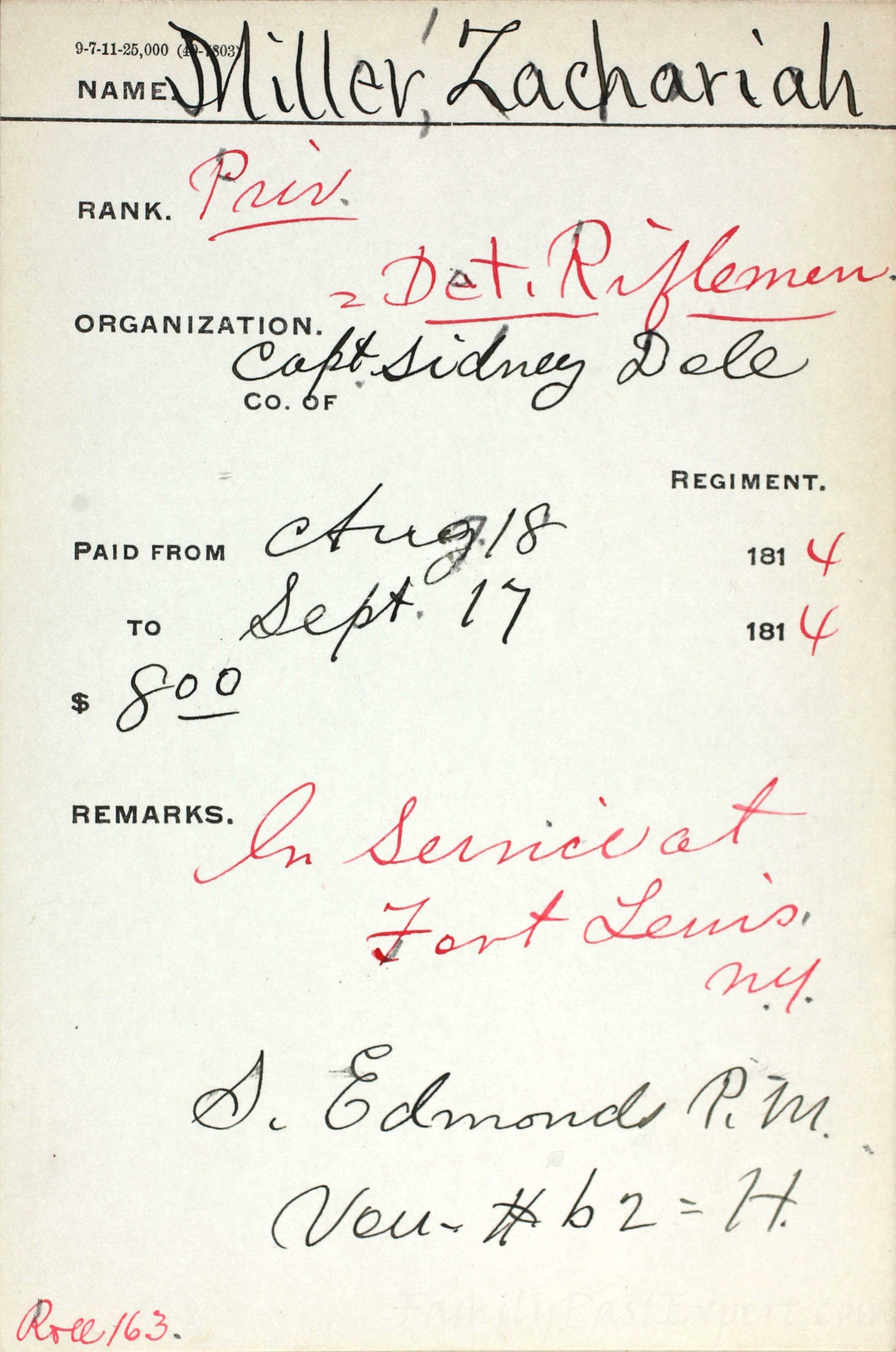

In about 1820, when he was about 28, Zachariah Miller married Catherine Leifheite.
Zachariah Miller and Catherine Leifheite had the following children:
- Eliza Margaret Miller was born in 1821 in Rensselaer, New York. She married Samuel G. Cole in 1842. She died on 25 Feb 1903 in Rensselaer, New York (Age: 82).
- John Robert Miller was born in 1823 in Rensselaer, New York. He married Harriet R. Huested. He died in 1910 in Rensselaer, New York (Age: 87).
- George Leifheite Miller was born on 14 Oct 1830 in Nassau, Rensselaer, New York. He married Jane Elizabeth Cornell on 09 Apr 1871 in Oroville, Butte, California. He died on 07 Dec 1921 in Big Rock, Kane, Illinois (Age: 91).
- Mary Ann Miller was born on 01 Aug 1835 in Nassau, Rensselaer, New York. She married Perry Wolcott. She died on 23 Apr 1892 in Rensselaer, New York (Age: 56).
- Mariah Miller was born about 1836 in Rensselaer, New York. She married Charles H. Cole.
- Calvin S. Miller was born about 1838 in Rensselaer, New York. He married Emma. He died on 18 Oct 1871 in Nassau, Rensselaer, New York (Age: 33).
Zachariah Miller had land in Rensselaer County, New York. We normally think of the great American dream of land ownership, but things were different in upstate New York. Way back in 1630, the area was controlled by the Dutch. They, and their successors, the British, granted a humongous portion of land along the Hudson river to what was called the Manor of Rensselaerswyek. In 1785, Stephen van Rensselaer assumed the title of Patroon and Lord of the Manor of Rensselaerswijck. With the help of Alexander Hamilton, his brother-in-law (the two men marred sisters), Stephen made plans to develop the manor and fill it with settlers. Van Rensselaer promised Revolutionary War patriots free homesteads. After finding a location, clearing the land, building a house, and living there free for seven-years, the farmers could get a durable lease. The leases could be passed down to heirs.
This all sounded great to some 3,000 families who accepted the offer.
But, after working their land for the required seven years, when tenants went to collect their durable leases they were not happy to find out about the terms of the rental agreements. Van Rensselaer required them to pay an annual rent in the form of wheat and to provide a day’s labor with a team of horses and wagon each year. The tenants also had to pay taxes as well as make improvements such as building roads. Tenants were allowed to use the land for agricultural purposes only. The patroon kept all the timber, mineral, and water rights to the properties. And, if a farmer wanted to sell his his farm, he had to pay one-fourth of the sale price to the patroon in order to be allowed to transfer the lease to another person.
The tenants were not happy. But, van Rensselaer would not budge. The settlers had to make a choice between accepting the terms of the lease and abandoning their 120-acre farms and all the buildings and improvements they had made over the past seven years. The settlers found themselves living on rented land in a way that was very similar to the old feudal system of Europe.
Zachariah Miller was part of several land transactions over the years. As an example, on 3 Jul 1833, he paid $600 to a man named Daniel P. Clark for land at Sand Lake, Rensselaer, New York. Zachariah didn’t own his land, he rented it. The land description came from an original lease from Stephen van Rensselaer to a man named Richard Huntly. The lease had changed hands through the years and then belonged to Daniel P. Clark. It amounted to about 115-acres of land. The terms of the original lease still applied, so for example, every January 1st, Zachariah was required to pay an annual rent of sixteen quarts of good merchantable winter wheat. A rough translation of the purchase follows.
This Indenture made the third day of July in the year of our Lord One thousand eight hundred and thirty three Between Daniel P. Clark of the City of New York Merchant of the first part and Zachariah Miller of the Town of Sandlake County of Rensselaer and State of new York of the second part witnesseth that the said party of the first part for and in consideration of the sum of six hundred dollars lawful money of the United States of America to him in land paid by the said part of the second part at or before the insealing and delivery of these presents the receipt whereof is hereby acknowledged has granted bargained sold aliened remised released conveyed and confirmed and by these presents doth grant bargain sell alien remise release convey and confirm unto the said party of the second part and to his heirs and assigns forever All that certain farm lot or piece of land situate lying and being in the Town of Sandlake in the County of Rensselaer now in the possession of the same parties of the first part bounded and described in an original lease of said premises from Stephen Van Rensselaer Esquire to Richard Huntly and dated the ninth day of December One thousand eight hundred and six as follows. Beginning at a marked white oak tree standing in the north line of Phillips Town / now part of the Town of Sandlake as aforesaid / and at the distance of fourteen chains and forty links eastward of the four mile stake and at the southwest corner of the farm leased the 23rd day of April One thousand seven hundred and ninety three to George Shipman and runs from the said White Oak tree due north thirtytwo chains then due West forty eight chains and thirty links then due south two chains and twenty links then south nineteen degrees west two chains and three links then south fifteen degrees forty-five minutes east eighteen chains and five links then south thirteen degrees thirty minutes west fourteen chains and twentytwo links to an iron wood stake and stones in the before mentioned north line of Philipstown / then so called / thence along the same north eightysix degrees fortyeight minutes east fortynine chains and eighty links to the place of beginning containing one hundred and fifty three acres of land excepting and reserving out of and from the above described premises a certain lot situate on the western part of the said above described premises and adjoining the lands of the late Thomas Frothingham deceased which said piece of land hereby excepted and reserved was lately owned by Snyder and is now in the occupation of Daniel Thompson and contains thirtyeight acres of land subject however and it is expressly understood by and between the parties to these presents that the above conveyed premises are subject to all the rents covenants conditions reservations and restrictions in the said above mentioned original lease from Stephen Van Rensselaer Esqr. To Richard Huntly aforesaid. Also all that certain Lot piece of parcel of land adjoining the above beginning at a point on the west side of the Highway and runs due north to the corner of a farm leased to James Hemsted then south 86 degrees & 40 minutes west to a stake and stones then southwardly as the fence now runs to the road and then along said road to the place of beginning containing ten acres of land subject to the payment to Stephen Van Rensselaer Esqr. of the yearly annual rent of sixteen quarts of good merchantable winter wheat on the first day of January each year Together with all and singular the tenements hereditaments and appurtenances thereunto belonging or in anywise appertaining and the reversion and reversions remainders and remainders rents issues and profits thereof and also all the estate right title interest property possession claim and demand whatsoever as well in Law as in equity of the said part of the first part of in or to the hereinbefore described premises and every part and parcel thereof with the appurtenances unto the said part of the second part his heirs and assigns to his and their own proper use and behalf forever. And the said party of the first part for himself his heirs executors and administrators do covenant promise and agree to and with the said party of the second part his heirs and assigns the above mentioned & described premises in the quiet and peaceable possession of the aid party of the second part his heirs and assigns against the said party of the first part his heirs and against all and every person & persons whomsoever faithfully claiming or claim to the same except as to the reservations and exceptions aforesaid shall and will Warrant and by these presents forever defend. In witness whereof the said party of the first part hath hereunto set his hand and seal the day and year first above written.
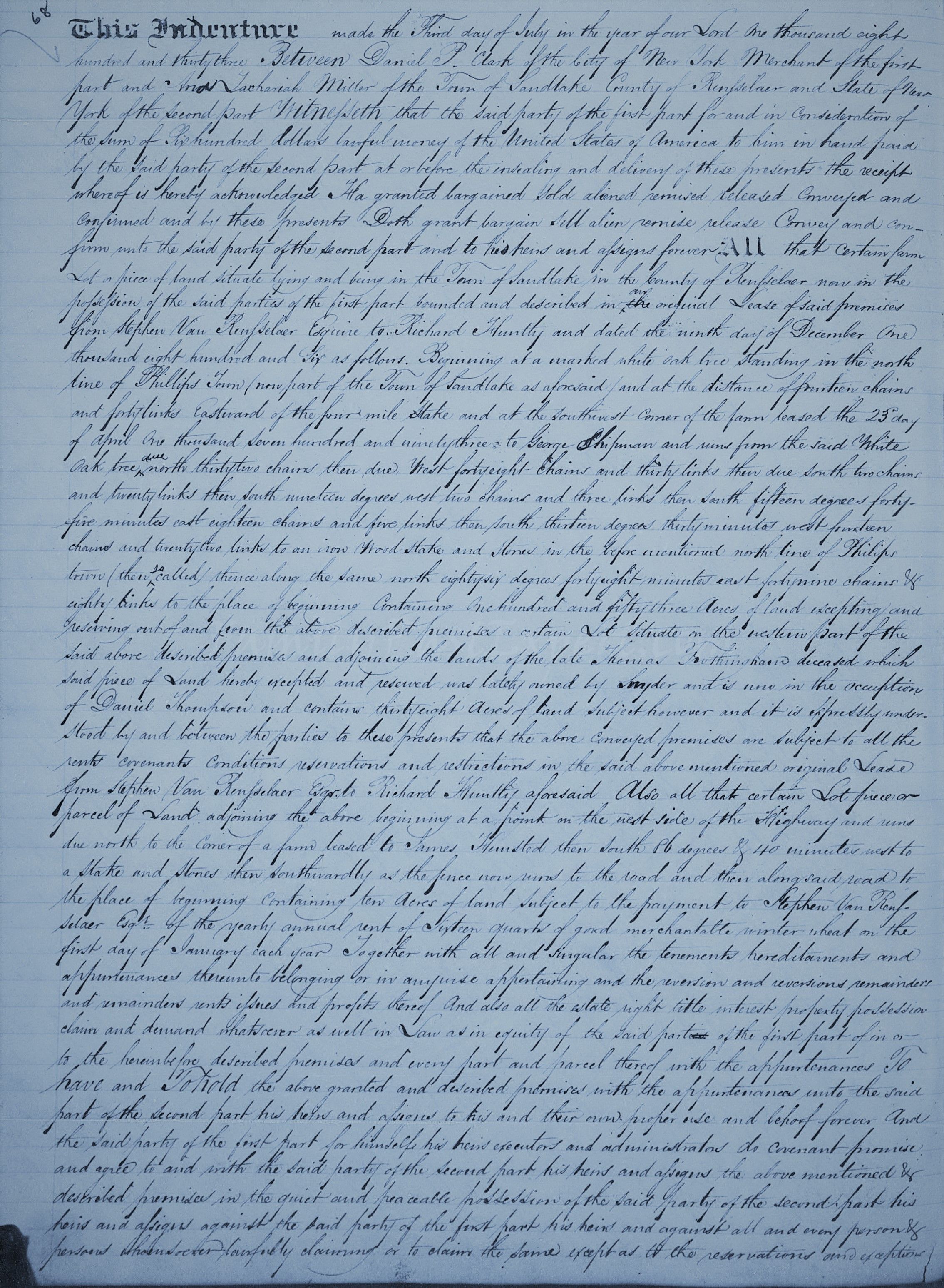
About three and a half years after they bought it, on 13 Dec 1836, Zachariah and his wife Catherine, sold the lease for the Sand Lake land. They had paid $600 and sold it for $630. The agreement states that the land was subject to all the rents covenants conditions reservations and restrictions of the original lease from van Rensselaer. If that was the case, then the Millers would have had to pay $157.50, a quarter of the purchase price, to van Rensselaer. So instead of a small profit, the couple probably took a loss with this sale.
It is interesting that Catherine Miller was part of the sale and that she was examined privately to make sure that she agreed to the sale “freely and voluntarily without any fear or compulsion of or from her said husband.”
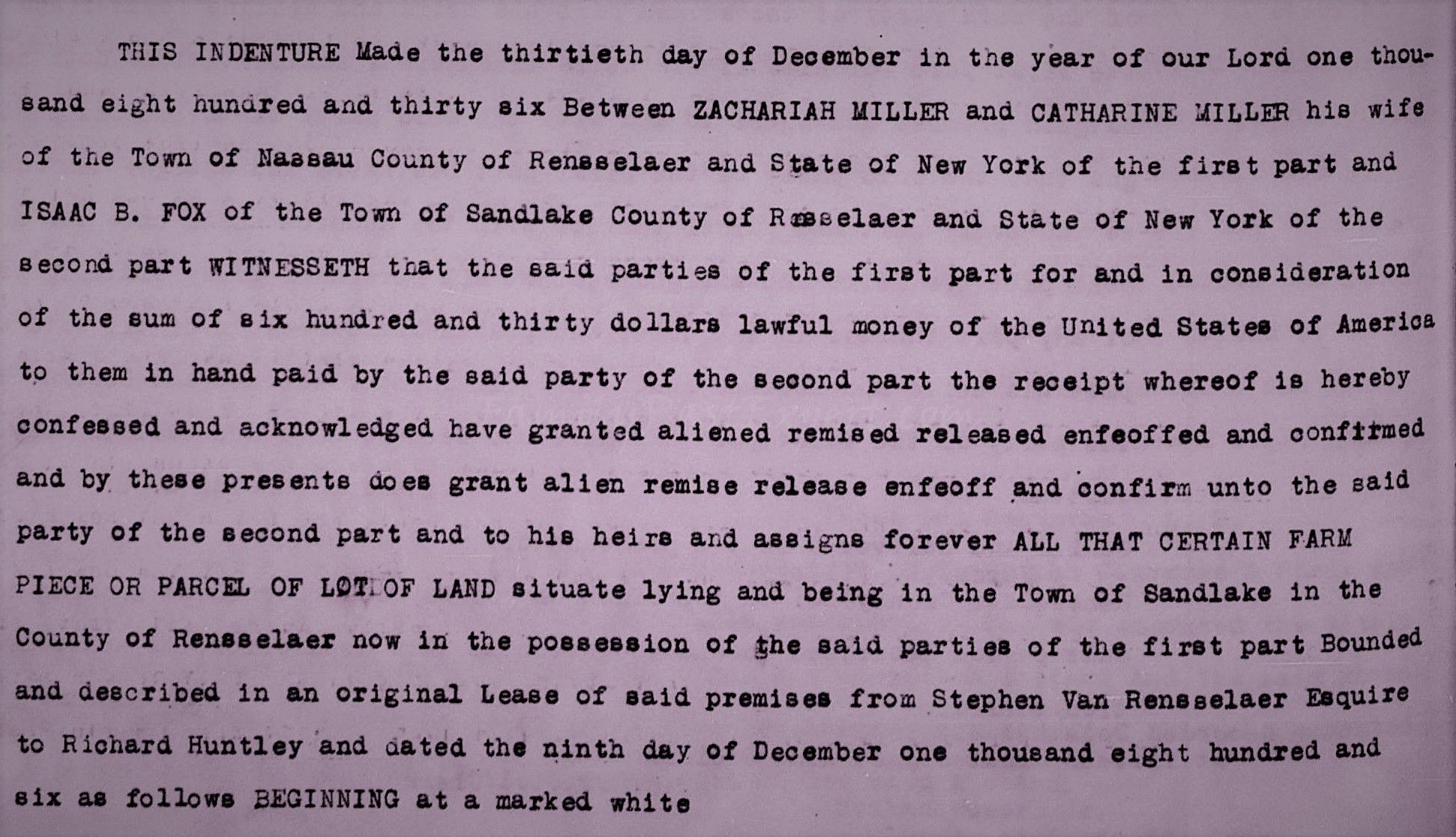
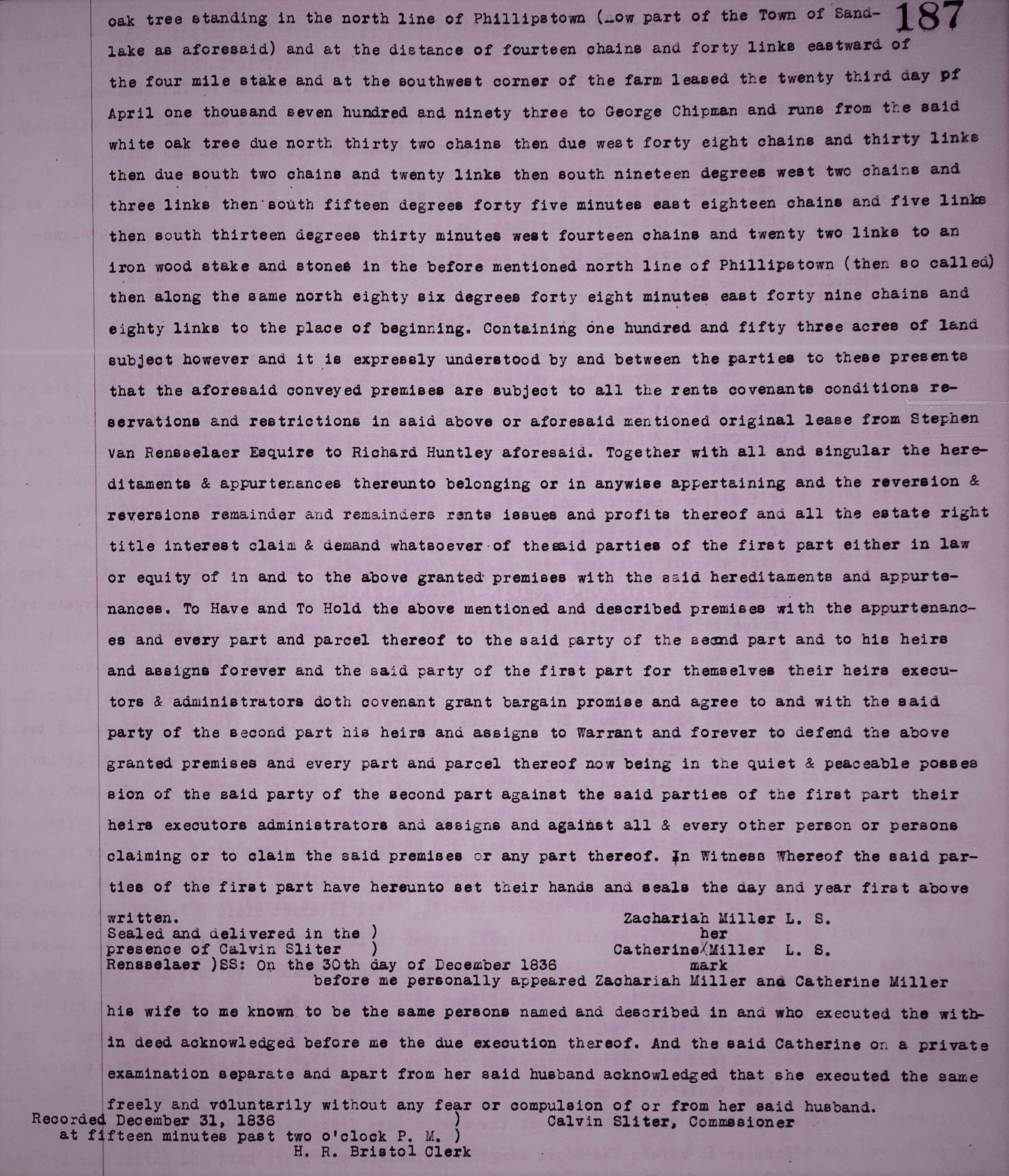
As another example, before selling the Sand Lake land, Zachariah bought a lot in the town of Nassau on 26 July 1836. The transaction was certified by the sheriff and seems to have been part of a complicated series of property transfers.
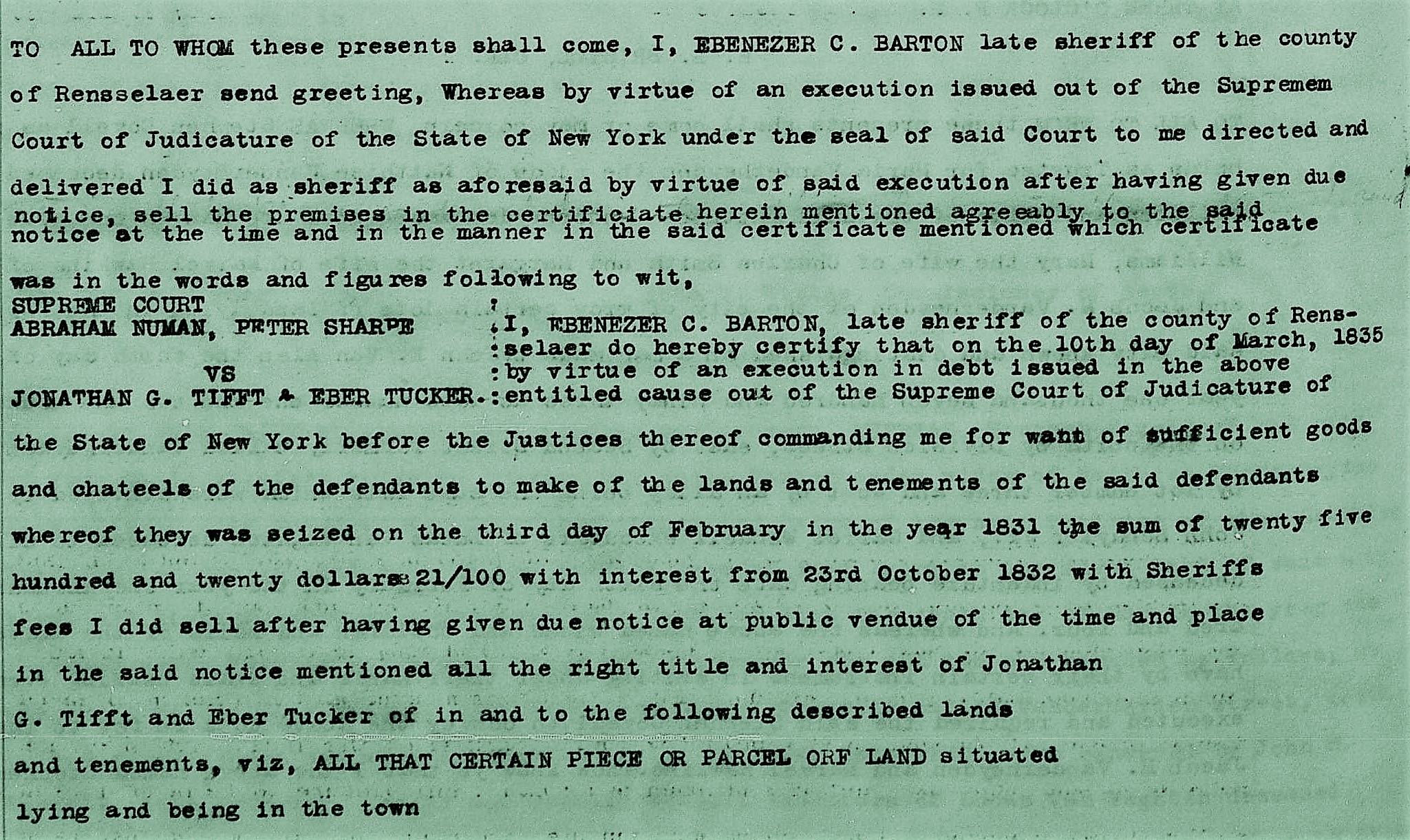
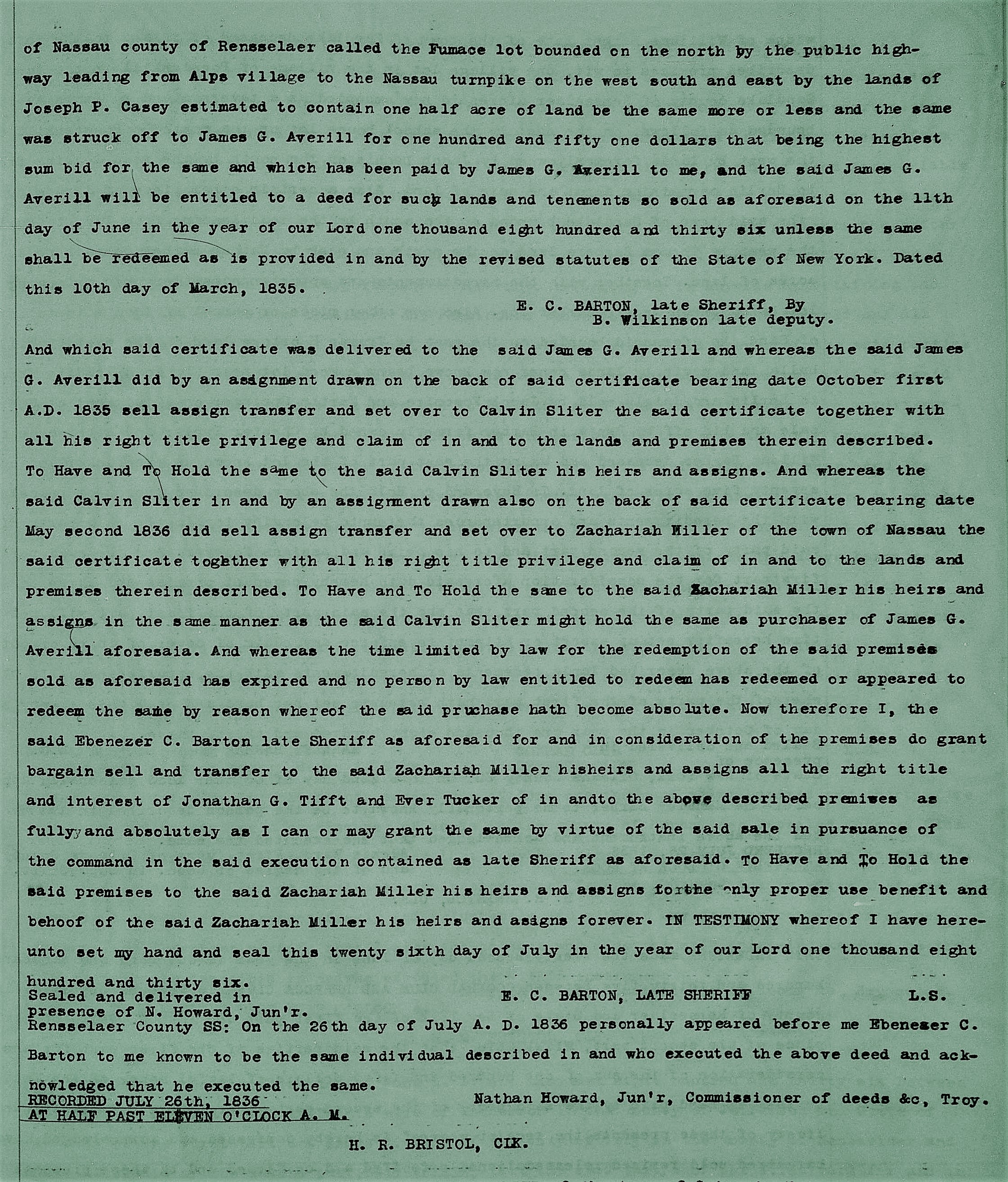
Soil conditions in Rensselaerswijck manor were not very good and a lot of tenants fell behind on their annual rent payments. Stephen van Rensselaer didn’t always worry too much about the delinquent rents. But, he died in 1839 and things changed. His estate was split between his two sons. In the will, the sons were also told to immediately collect back rents from the tenants. So, they did. But, most of the tenants just ignored the rent collectors. Some of the tenants tried to negotiate with the brothers, hoping to get lenience on the overdue rents and to get lease terms changed so that people could purchase the land instead of having to continue renting. The van Rensselaer brothers would not negotiate. Instead they brought in the law to seize property and have people evicted.
Thus began the Anti-Rent Wars.
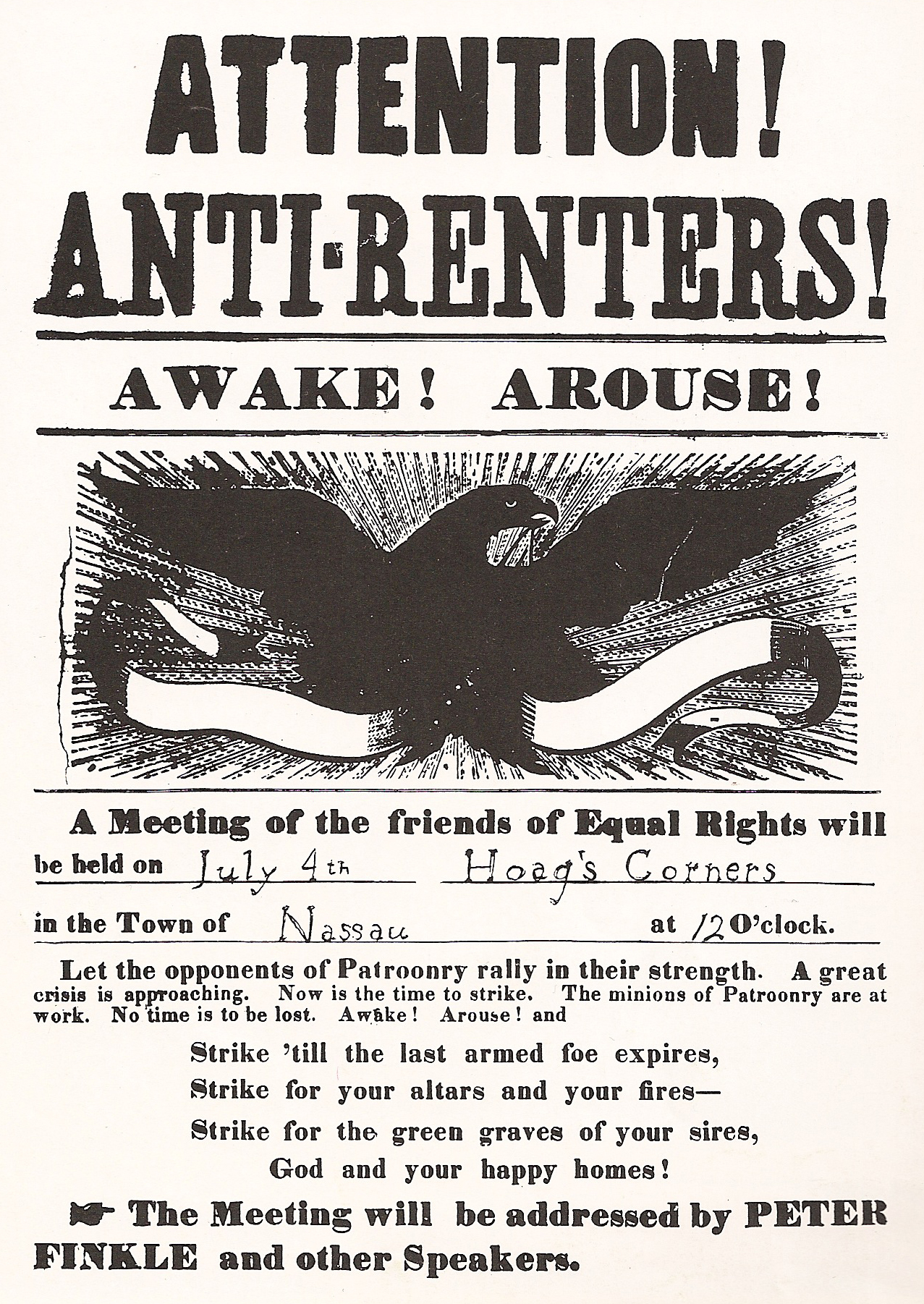
Between 1840 and 1846, tenants refused to pay rent and things got violent. The town of Nassau, where the Millers lived, was the center of the Anti-Rent War in Rensselaer County. Farmers joined the anti-rent society there but kept their identities secret. The meetings were usually held at the old Martin tavern, but the members came in disguise, often dressed as Native Americans, and were not addressed by name. Though they took precautions to protect their identities, eventually the landlords got a list of the name of some of the society’s leaders and took legal actions against them. It was quite “exciting” near Nassau. The 1897 book, Landmarks of Rensselaer County, shared one story from the times.
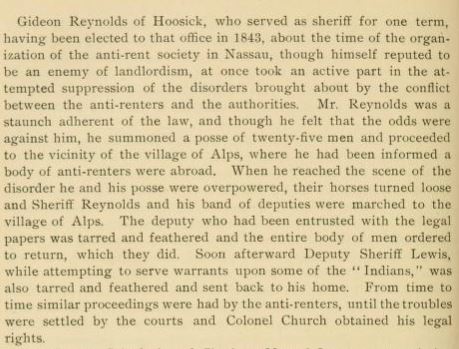
In 1845, the New York State Legislature made it illegal for the landlord to seize goods of a defaulting tenant and began taxing the income that the landlord made from rent. In 1846, they prohibited agricultural land leases that lasted more than 12 years. It left the existing leases intact though. Through the 1850s and 1860s, most of the land was released to tenants or sold. Though, some people continued to pay rent to the Van Rensselaer family estate way into the 20th century.
Despite the land situation in Rensselaer County, Zachariah Miller lived there as a farmer. He was recorded at Nassau in the 1850 and 1860 census records. The agriculture schedules from those years give us a glimpse into his life on the farm.
| CENSUS YEAR | |||
| 1850 | 1860 | ||
| Acres of Land | Improved | 50 | 30 |
| Unimproved | 31 | 50 | |
| Cash value of Farm | $1,000 | $2,000 | |
| Value of farming Implements and Machinery | $200 | $75 | |
| Live Stock, June 1st 1850 | Horses | 4 | 2 |
| Milch Cows | 7 | 5 | |
| Working Oxen | 2 | 6 | |
| Other Cattle | 4 | 9 | |
| Swine | 6 | 6 | |
| Value of Live Stock | $500 | $850 | |
| Produce during the year ending June 1, 1850. | Wheat, bushels of. | 0 | 44 |
| Indian Corn, bushels of. | 75 | 0 | |
| Oats, bushels of. | 15 | 80 | |
| Irish potatoes, bush, of. | 100 | 15 | |
| Buckwheat, bushels of. | 7 | 15 | |
| Butter, lbs. of. | 400 | 700 | |
| Hay, tons of. | 35 | 30 | |
| Beeswax and Honey, lbs. of. | 20 | 0 | |
| Value of Animals slaughtered. | $75 | $85 | |
Zachariah Miller died on 12 Mar 1869 in Rensselaer, New York at the age of 77. He was buried in Sand Lake Union Cemetery, Sand Lake, Rensselaer, New York.
He left a will bequeathing his body to dust and his soul to God. He also named his wife and children. His estate was probated on 17 May 1869 in Rensselaer, New York. The oldest son, John, was the executor. During the probate process, an inventory was taken and the heirs were identified.
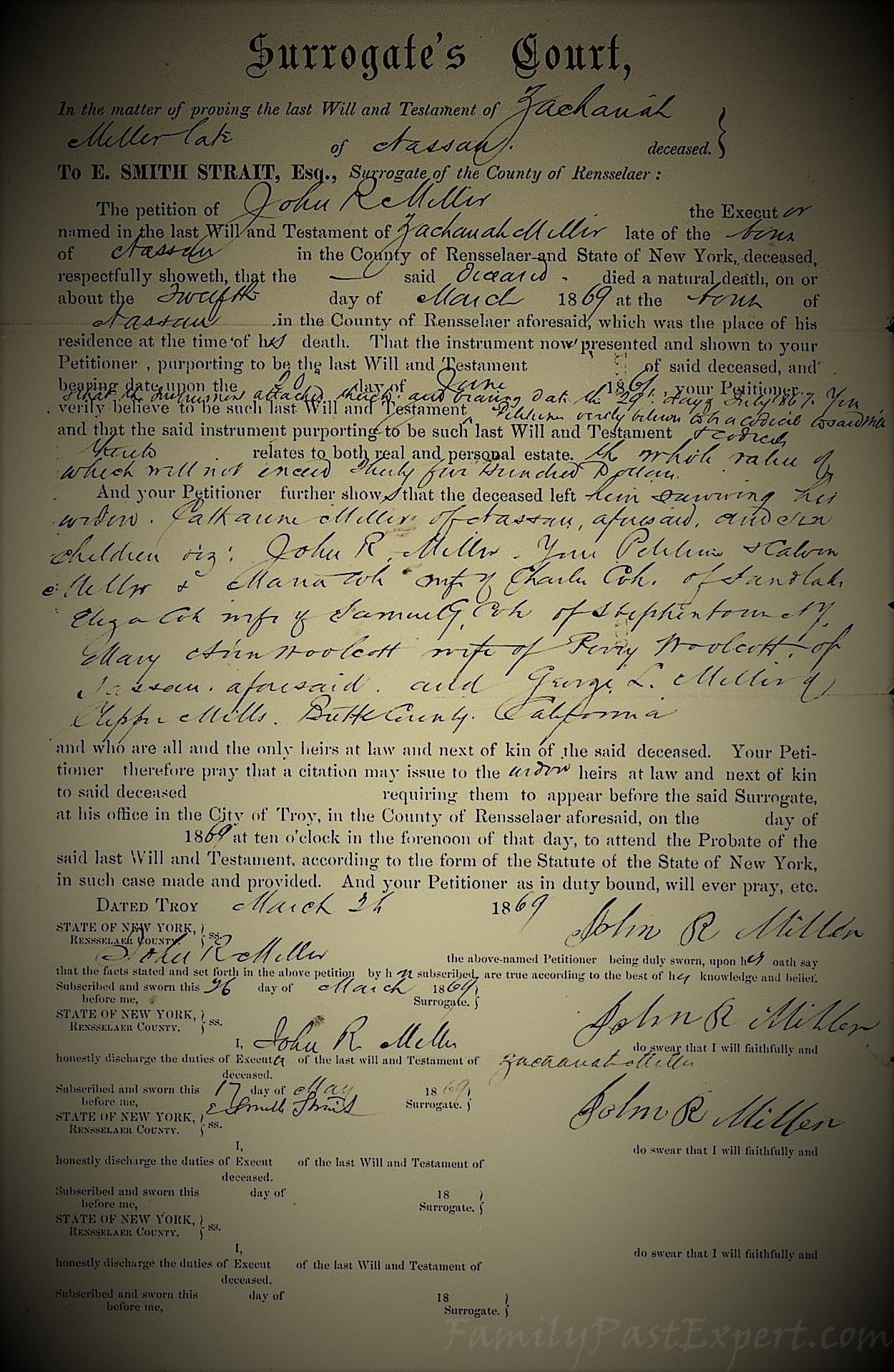
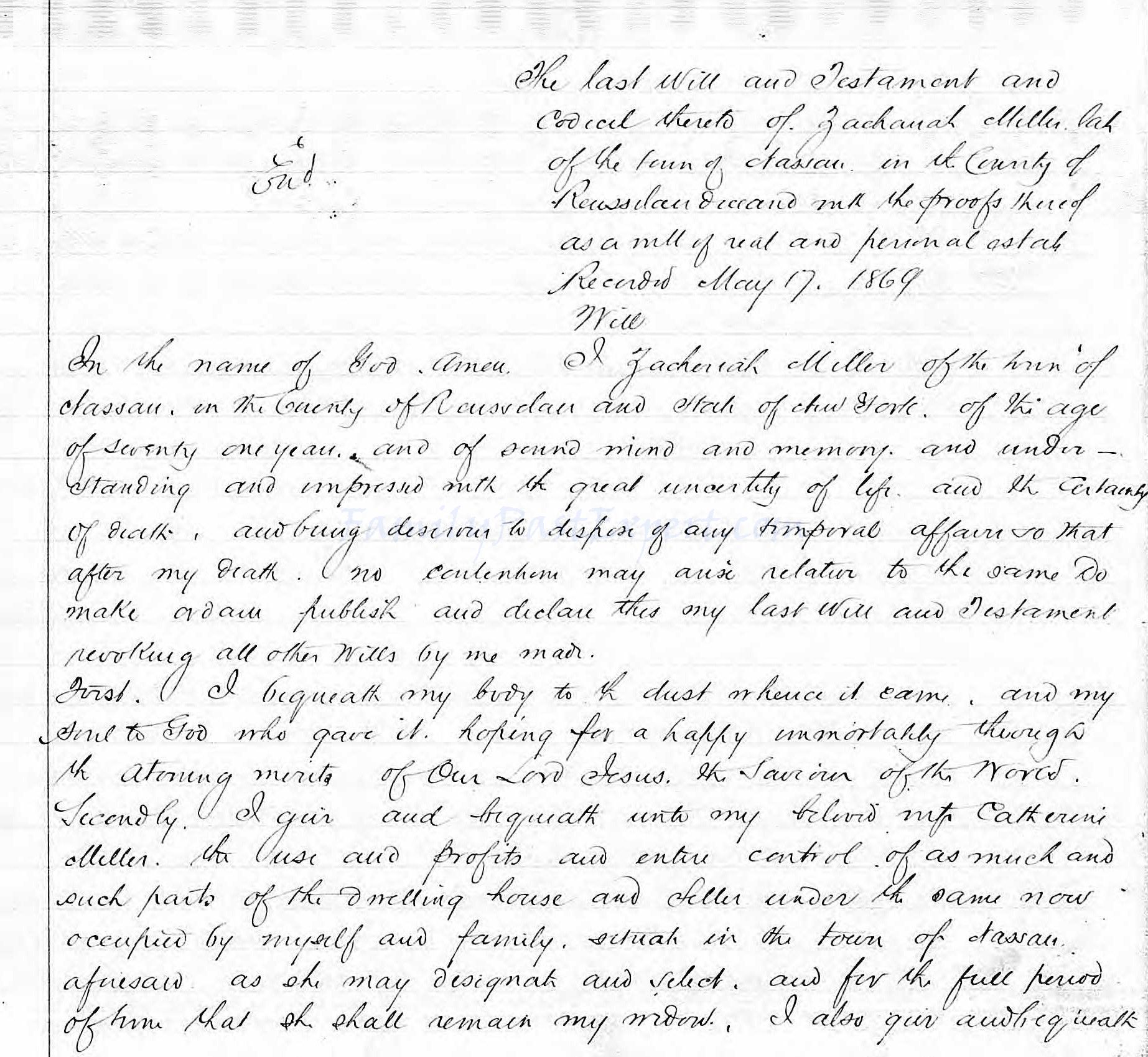

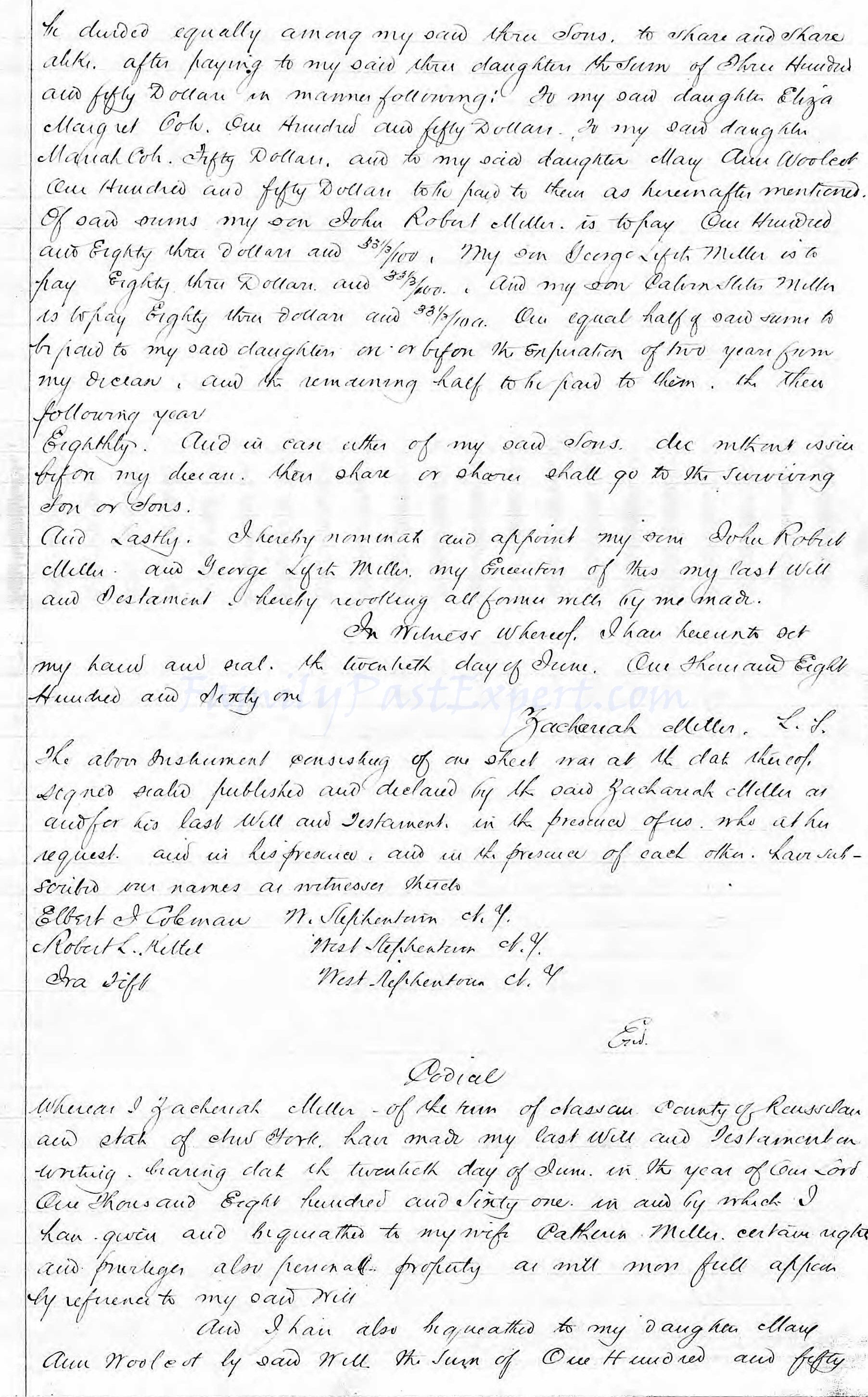
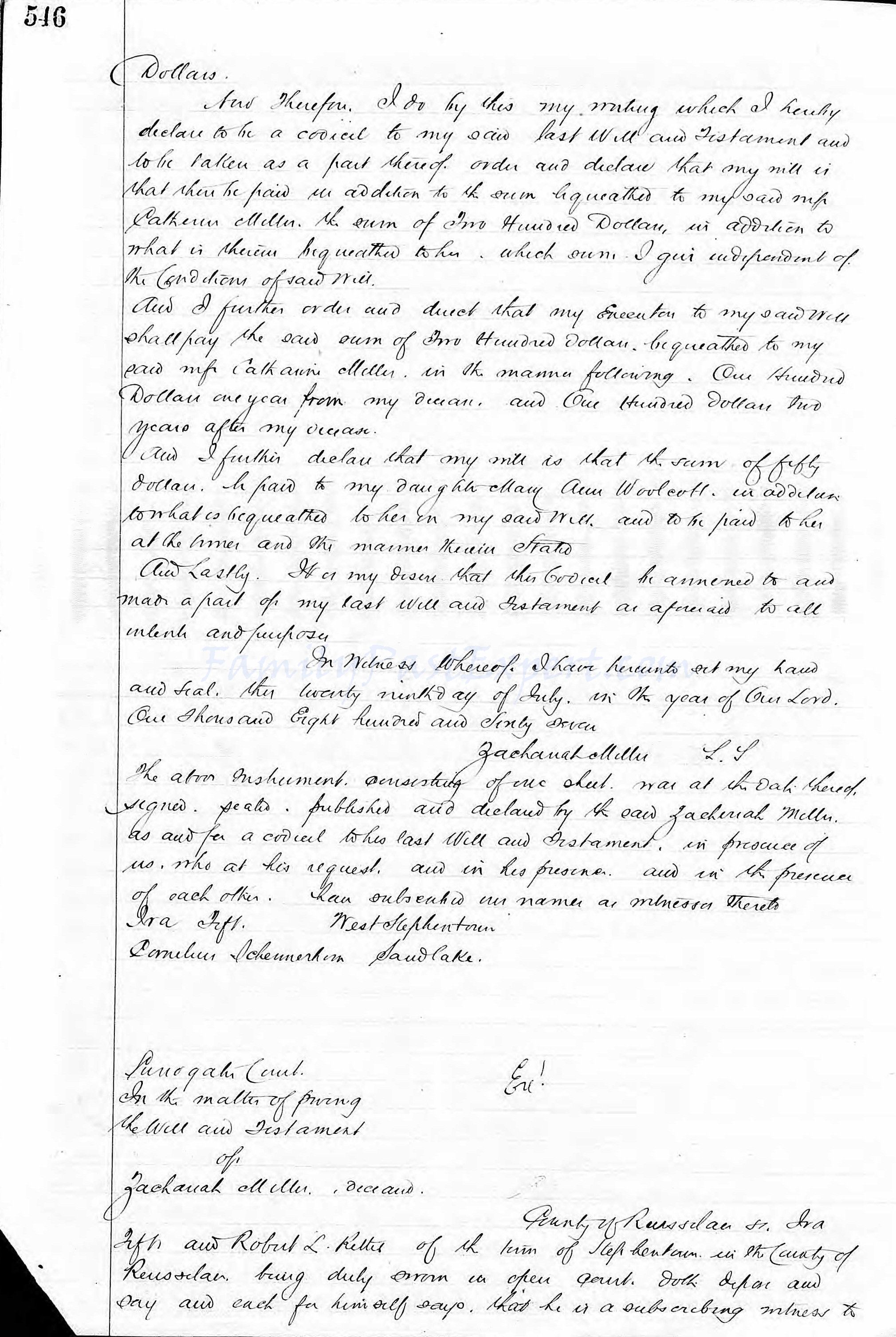
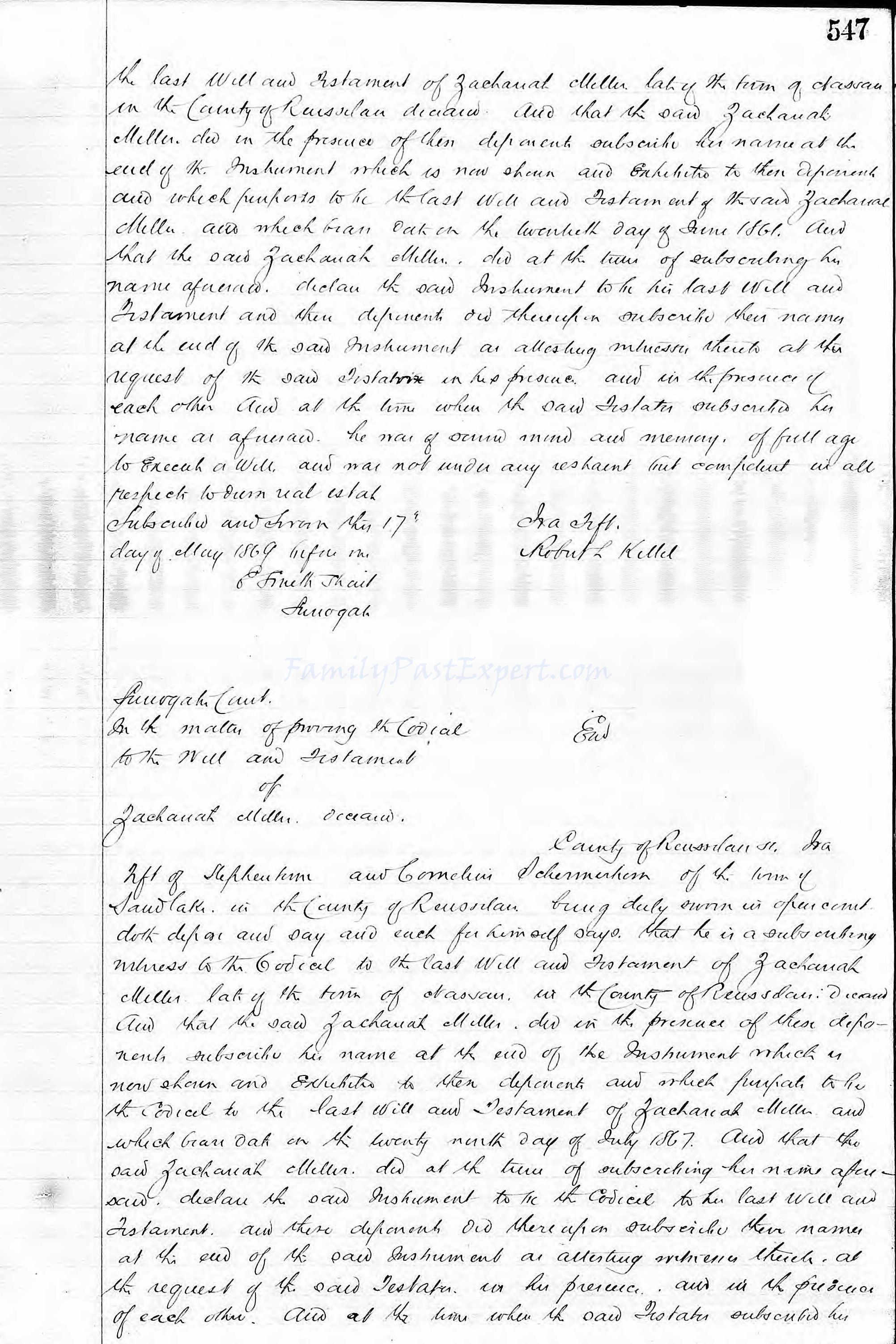
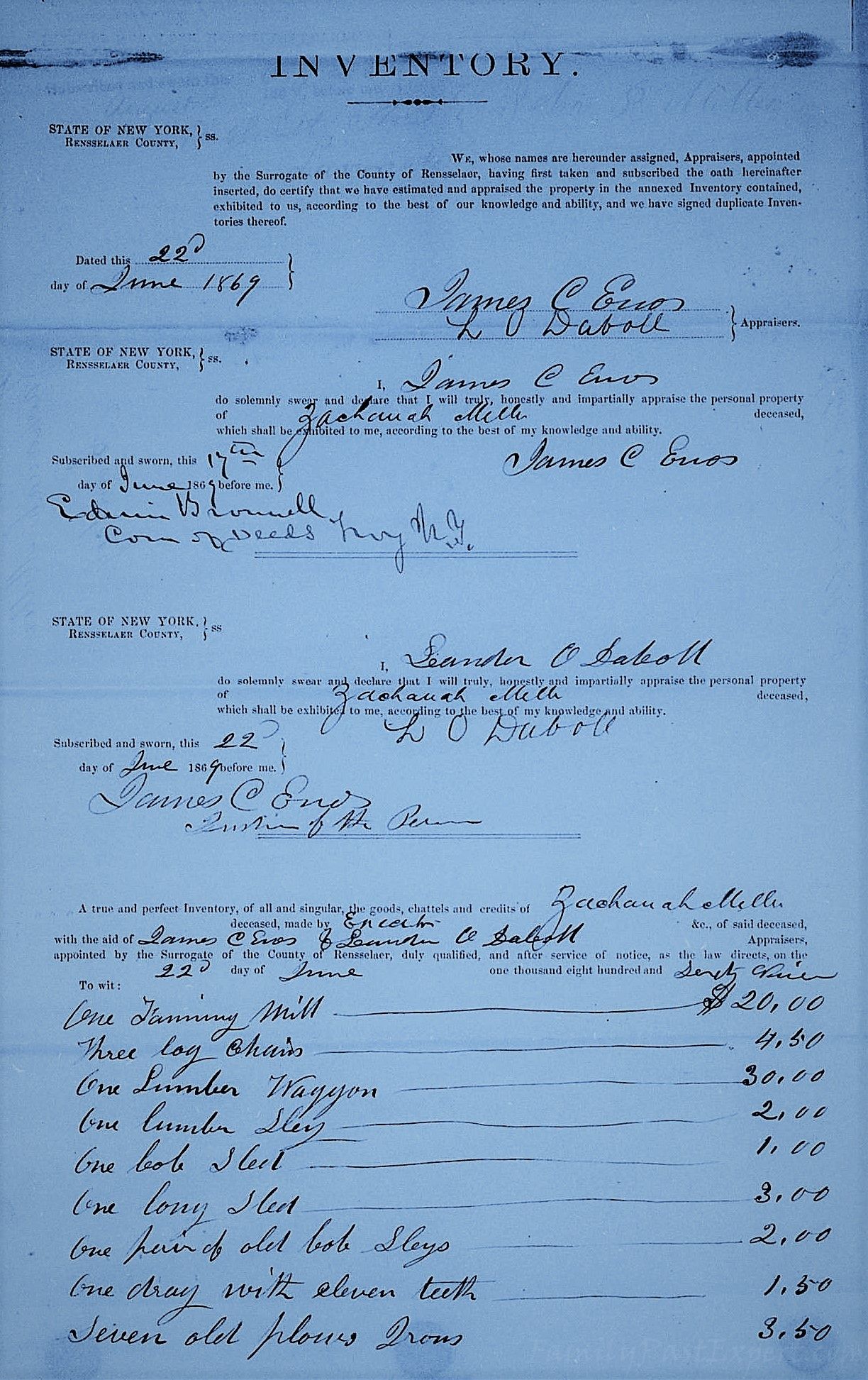
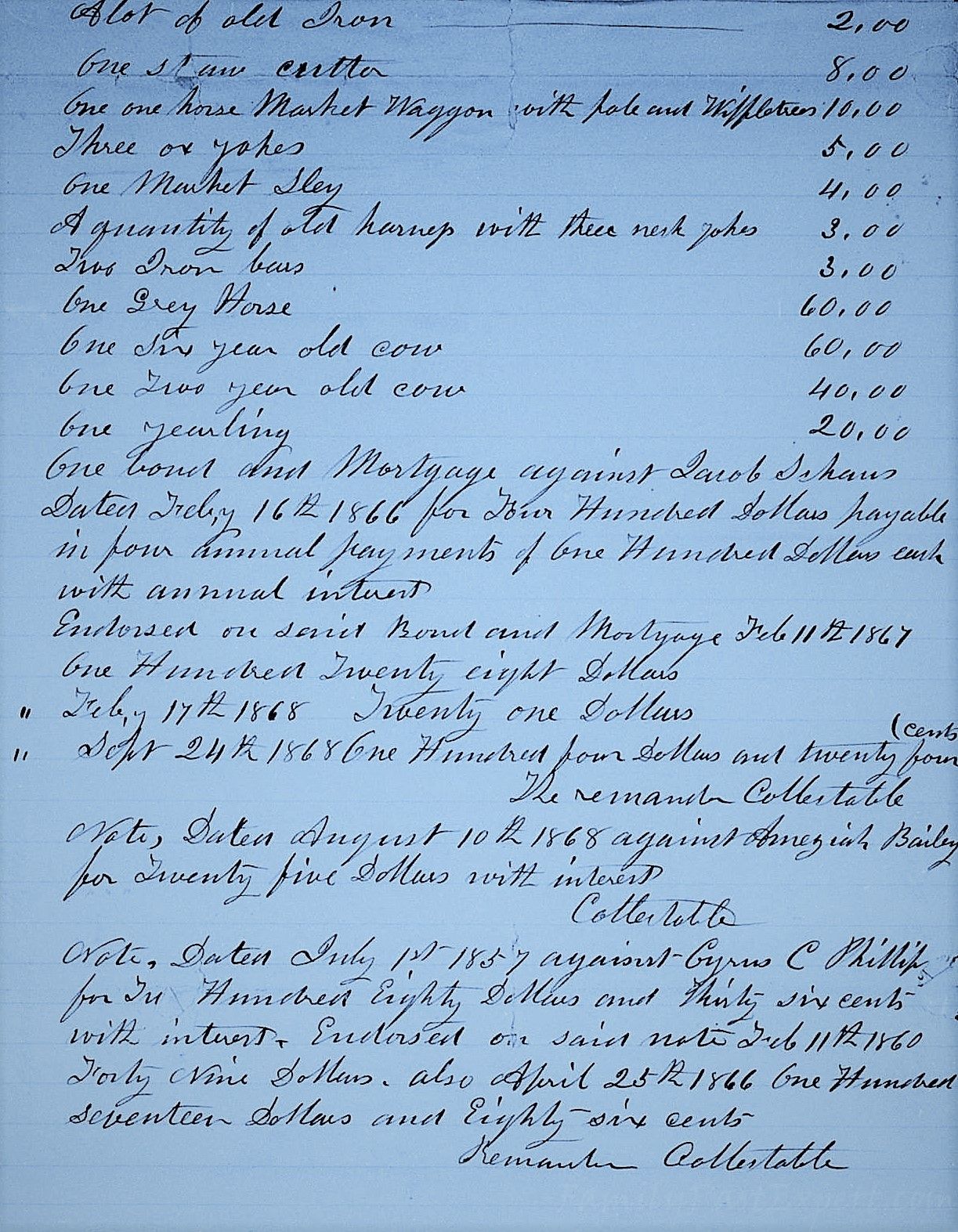
Where is he in the tree?
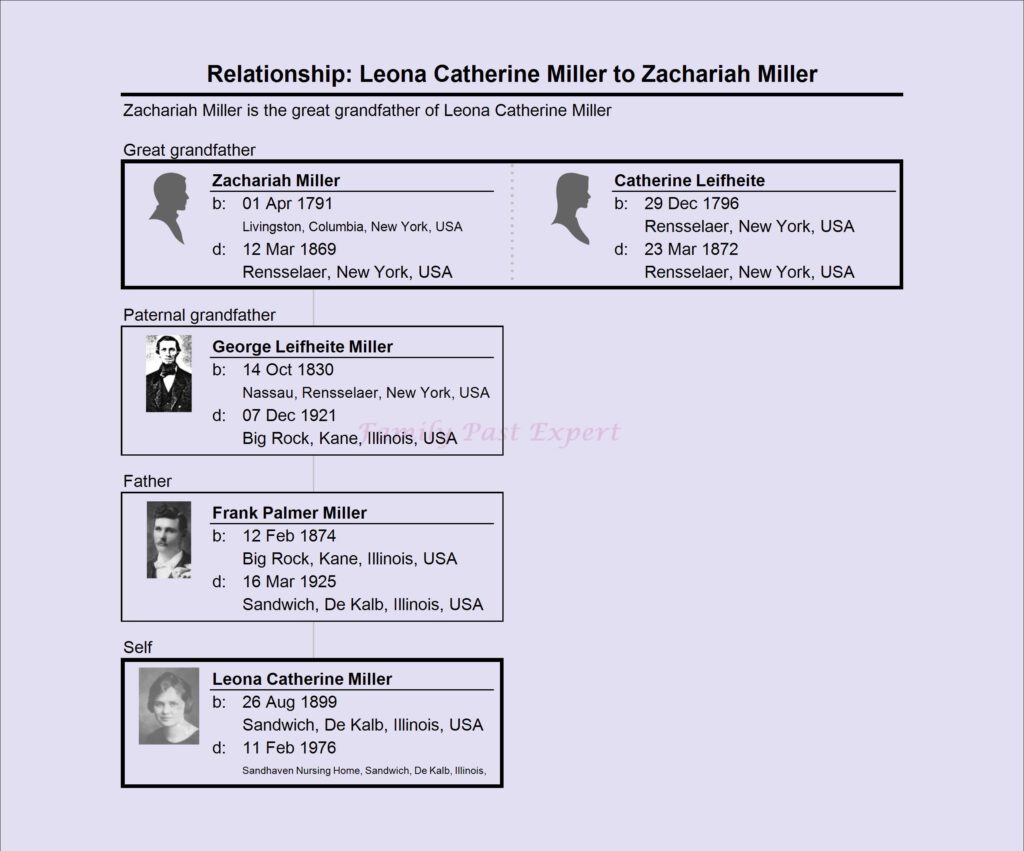

Where can I learn more?
The Miller Family
- Publication date: October 2022
- Pages: 548
- 548 pages
- Formats:
- This book explores our Miller family history. It traces hundreds of descendants of Zachariah Miller who lived most of his life in Rensselaer County, New York. Detailed biographies are provided for the families of our direct line from Zachariah Miller through George Leifheite Miller and Frank Palmer Miller who farmed in Illinois.
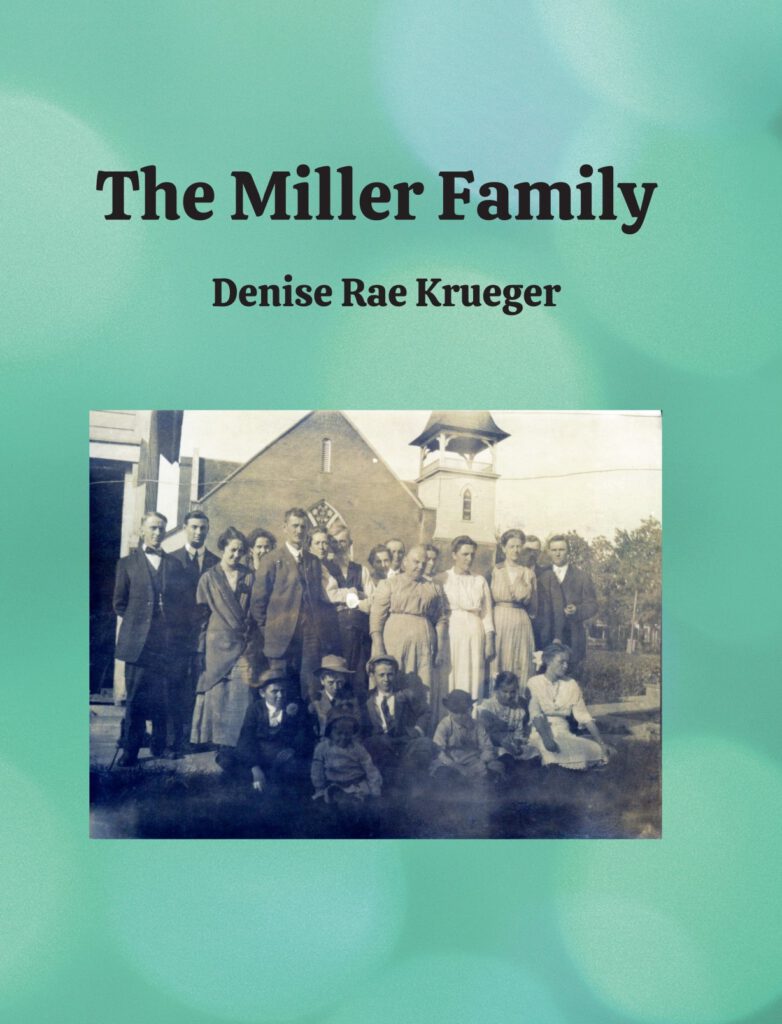
Selected Sources:
George Baker Anderson, Landmarks of Rensselaer county, New York (Syracuse: D. Mason & company, 1897), Archive.org (https://archive.org/details/landmarksofrenss00ande : accessed 27 Mar 2017), pp. 547-8.
Nathaniel Bartlett Sylvester, History of Rensselaer Co., New York (Philadelphia: Everts & Peck, 1880), Digital Images (https://archive.org/details/historyofrenssel00sylv : accessed 25 Mar 2018), p. 73.
“Van Rensselaer Manor Papers, Mapping and Surveying the Manor,” New York State Library (http://www.nysl.nysed.gov/mssc/vrm/h4mapping.htm : accessed 27 Mar 2018).
“Van Rensselaer Manor Papers, The Anti-Rent Wars,” New York State Library (http://www.nysl.nysed.gov/mssc/vrm/h4mapping.htm : accessed 27 Mar 2018).
“Van Rensselaer Manor Papers, The End of Dutch Culture in New Netherland,” New York State Library (http://www.nysl.nysed.gov/mssc/vrm/h6end.htm : accessed 27 Mar 2018).


Leave a Reply